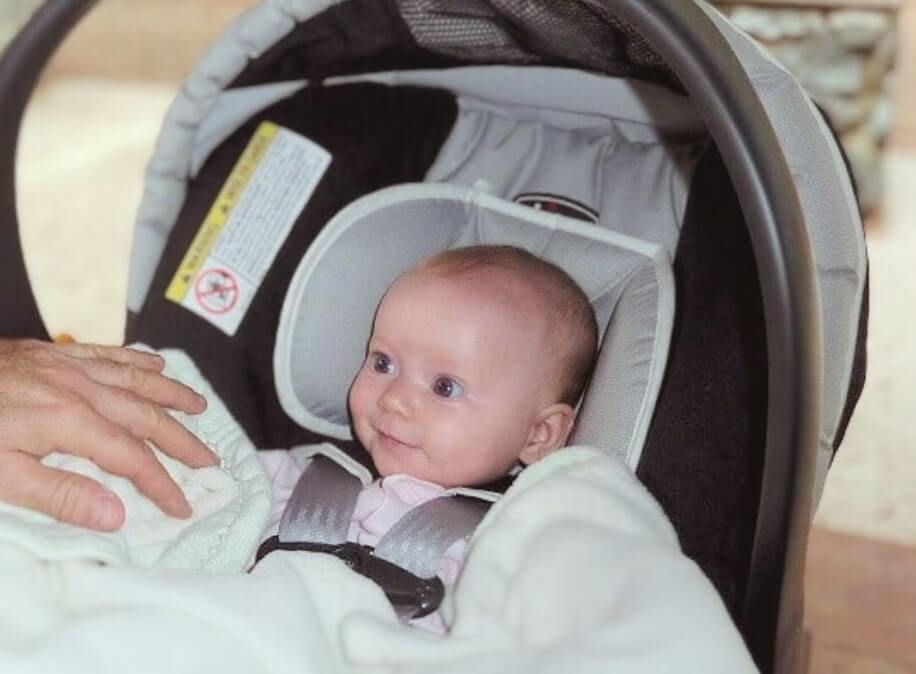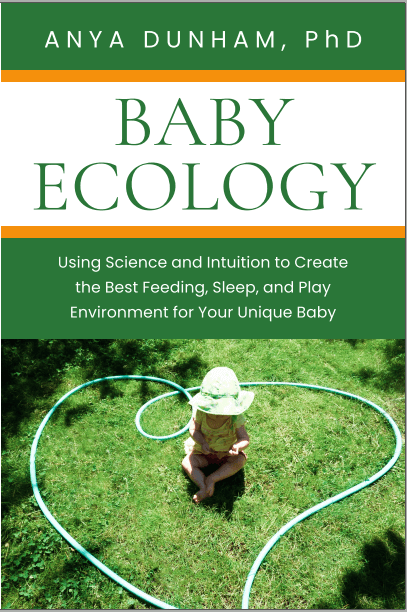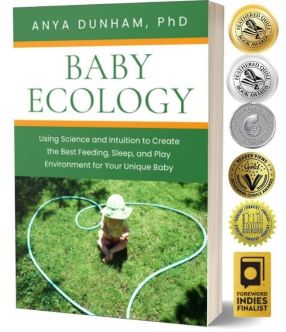Baby Ecology book is here! Learn more
Baby Ecology book is here!
- Home
- Baby-led feeding
- Feeding in car seat
Is feeding baby in a car seat OK?
by Anya Dunham, PhD
Why feeding baby in a car seat is never a good idea – and what you can do instead.

If you’ve been around this space or read Baby Ecology, you know I often say that in parenting, there is rarely a solid justification for the black-and-white, the one-right-thing, the “should”, or the “never”: usually, there is a range of good options from which you can choose what works best for your baby and your family (like the ONE approach). Well, this is one of the exceptions: feeding baby in a car seat is never a good idea.
Feeding baby in a car seat is dangerous
Don’t give your baby a bottle or snacks – even soft squeezable pouches – when she’s strapped in a car seat. The reclined position of the car seat and the motion of the vehicle increase the risk of aspiration and choking - a life-threatening medical emergency where the airway becomes obstructed. It is possible to choke on soft food, and unlike gagging, choking is usually silent.1 Even if you notice the moment your baby begins to struggle, and even if you aren’t the driver, there is really no safe way to quickly help a choking baby in a moving vehicle. This is very important.
What about taking the car seat out at a rest stop and using it as a makeshift feeding chair?
If you have a bucket-type car seat, it may be tempting to remove it from the vehicle and feed your baby in it at a rest stop, using it as a makeshift baby seat or high chair. However, reclining in a bucket-type seat is not the best feeding position: in addition to, once again, a higher risk of choking because of the recline, the shape of the seat tilts baby’s pelvis and can put pressure on her esophagus, making eating uncomfortable.2
Before feeding, take your baby out of the car and out of the car seat
Take your baby out of the vehicle and out of the car seat and give her an opportunity to stretch, play, and move freely for a bit. During long car journeys, safety experts and car manufacturers generally recommend that babies should not be in a car seat for longer than 2 hours at a time. I have also seen the American Academy of Pediatrics (AAP) referenced to back up this advice, but could not find any specifics among the AAP recommendations (apart from important information on preemies and travel described in a box below). The advice to take breaks certainly makes sense: babies’ position in car seats is optimized for safety in case of an accident (the most important aspect), but is not optimal when it comes to movement and stretching. In addition, babies overheat more easily in car seats.
For young babies, it is advised to limit car journeys to 30 minutes or less at a time. Premature babies are prone to drops in blood oxygen saturation, and apnea or hypoventilation when in car seats, in up to 60% of infants studied.3-5 The (AAP) recommends that all preterm babies should undergo monitoring in a car seat before discharge from the hospital 6,7, something known as ‘the car seat challenge’. Recently, a small pilot study8 investigated the physiological effects on healthy term and preterm babies placed in a car seat at 30° and 40° angles with and without vibration (simulating the typical motion of a vehicle) for 30 minutes. Interestingly, both preterm and term babies showed increased heart rate and decreased blood oxygen saturation in the more upright car seat position with vibration. This study supports taking frequent breaks when travelling by car with young babies, even if your baby wasn’t born prematurely.
(Always follow your car seat manual to determine the correct way to install it; the angle varies from one car seat to another.)
Feeding on the go
If you’re bottle-feeding, take your baby out of the car seat and cradle her against you. Some of the long-term benefits of breastfeeding have been attributed to the nurturing and close contact — the touching and gazing — breastfeeding provides9; mothers and babies tend to touch and look at each other less during bottle-feeding than during breastfeeding.10 Yet, you absolutely can develop a close, nurturing feeding relationship when bottle-feeding formula. Cradle your baby against you so she can see your face, feel your touch and feel comfortable so she can eat well. Moms, dads, and other committed caregivers can follow this approach.
When feeding solids on the go, you can hold your baby on your lap or have her sit independently in front of you if she has the core strength and interest. Another option is to bring along a travel highchair, especially if it’s something you envision using at your destination.
And even during travel, remember to feed responsively: provide a safe and comfortable spot to eat, offer nutritious food, and then let your baby decide how much to eat.
Happy travels!
References
References
1. Chapin MM et al (2013) Nonfatal choking on food among children 14 years or younger in the United States, 2001—2009. Pediatrics 132(2): 275-281
2. Fernando N, Potock M (2015) Raising a healthy, happy eater: a stage-by-stage guide to setting your child on the path to adventurous eating. The Experiment, New York, NY, USA
3. Willett LD, Leuschen MP, Nelson LS et al. (1989) Ventilatory changes in convalescent infants positioned in car seats. J Pediatr 115: 451–455
4. Mullen D, Coutts J (2002) Monitoring premature babies in car seats: the car seat challenge. JNN 8: 129–131
5. Davis NL. Screening for cardiopulmonary events in neonates: a review of the infant car seat challenge. J Perinatol 2015;35:235–40.
6. American Academy of Pediatrics Committee on Accident and Poison Prevention (1991)Safe transportation of premature infants. Pediatrics 87: 120–122
7. Bull MJ, Engle WA, Committee on Injury, Violence, and Poison Prevention and Committee on Fetus and Newborn; American Academy of Pediatrics. Safe transportation of preterm and low birth weight infants at hospital discharge. Pediatrics 2009;123:1424–9.
8. Arya R, Williams G, Kilonback A et al (2017) Is the infant car seat challenge useful? A pilot study in a simulated moving vehicle. Archives of Disease in Childhood - Fetal and Neonatal Edition 102: F136-F141
9. Luby JL et al (2016) Breastfeeding and childhood IQ: the mediating role of gray matter volume. Journal of the American Academy of Child and Adolescent Psychiatry 55(5): 367-375
10. Lavelli M, Poli M (1998) Early mother-infant interaction during breast- and bottle-feeding. Infant Behavior and Development 21(4): 667-683
Using hundreds of scientific studies, Baby Ecology connects the dots to help you create the best environment for sleep, feeding, care, and play for your baby.
Warmly,
Anya


